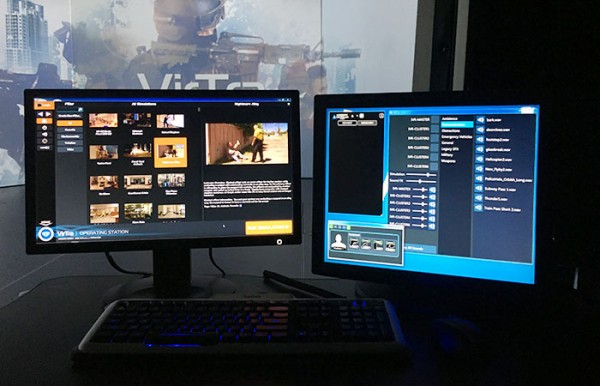
When VirTra’s use of force training simulators are used in Law Enforcement or Military Training, the training processes work in much of the same way. One aspect of VirTra’ s system involves three major parts. These three parts functions together and they are: scenario debriefing, TMaR (Trainee Monitoring and Recording), and the Instructor Control Panel.
Scenario Debriefing
VirTra’s use of force simulators have a unique option that the instructor is able to “Debrief” the trainee immediately after they go through a scenario. It is extremely beneficial to be able to replay the scenario in slow motion and look at what force was used, was it verbal, less lethal or lethal force. Trainees are able to walk the instructor through their thought process while seeing the scenario in front of them while the instructor is able to point cues that the trainee may have missed. This feedback is critical to the learning process.
Being able to debrief and collect data from all trainees will show where additional training needs to be focused on. It will also train and remediate training flaws in a controlled environment. Where remedial training can be done prior to a real-life situation. This alone will save officers, solders and civilian lives. Because VirTra’s use of force simulations are customizable, it is possible for instructors to alter the scenario or even put trainees into different scenarios that will help them address weaknesses and better prepare them for the line of duty.
Trainee Monitoring and Recording (TMaR)
Trainee Monitoring and Recording, or TMaR, allows instructors to monitor and record their trainees while they are in the simulator responding to the events. This is advantageous to both the trainee and the trainer. The functionality of this system being able to be replayed during the debrief stage, on the same screen as the scenario makes for an excellent training aid. Trainers are able to point out to the trainee anything that they are doing right or wrong, from having a finger on the trigger to missing an aggressor due to their tunnel vision. This isn’t just an instructor telling a trainee that they need to work on something. This is video proof that is replayed during debrief with the scenario on the same screen showing the trainees reaction to the scenarios.
As the scenario plays out and the trainee responds to the simulation, the instructor can make playback notes for the trainee. Then, the picture-in-picture functionality provides an awesome debriefing tool, allowing the instructor and trainee to review the entire session play-by-play or simply revisit any problem areas that may need addressing. TMaR is an optional package that works alongside VirTra’s use of force simulators.
Trainees who can view their actions during a scenario are far more likely to improve the ways in which they react to those scenarios in the future, whether during a simulation or in the real world. With TMaR and the ability to watch the entire scenario or even parts of the scenario, even in slow motion, it becomes easier for instructors to help trainers understand strengths and weaknesses.
Instructor Control Panel
The instructor control panel is where the instructor can customize the chosen scenario in several unique ways, including adding audio to choosing between different branches that change the outcome of a scenario depending on the trainees’ actions or reactions to what is happening in the simulator. What’s more, the instructor also has access to VirTra’s Threat-Fire. Threat-Fire is a patented piece of equipment that VirTra is the soul source supplier of. This system gives the instructor the ability to stimulate the stress response of the trainee for any type of situation which raises the trainees heart rate, causes vasoconstriction, activates other endocrine system responses. These all being the response to any stress in the field.
Using these unique features of VirTa’s judgmental use of force simulator will give the trainee a realistic approach to real life scenarios while in a controlled environment where the trainee can learn from their own behaviors and reactions giving them an opportunity to change bad behavior and tactics while honing in the good behavior and tactics. Being able to put trainees through real life situations prior to it actually happening will save officers, soldiers, and civilian lives.
Recently Published
Join Our Newsletter







